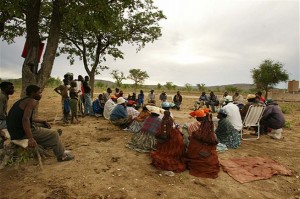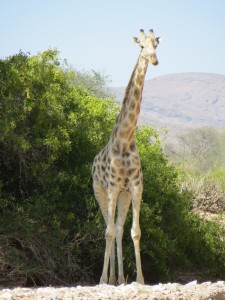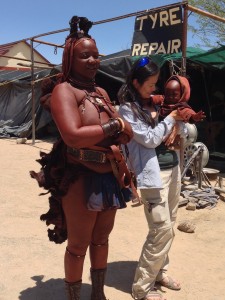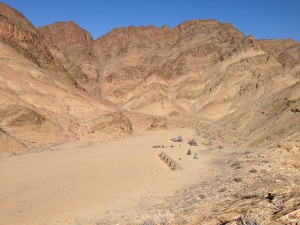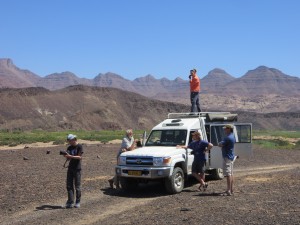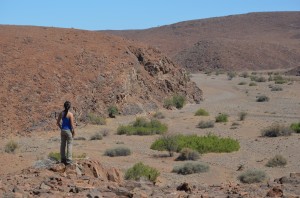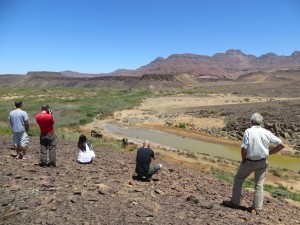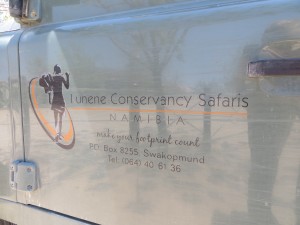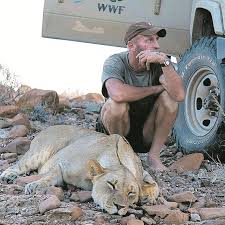
“Make your footprint count.” he said with conviction. We were a caravan of Land Rovers driving back from a week-long desert safari visiting conservancies in the Kaokoveld region of Northwestern Namibia. It was hot and dusty, as we drove the bumpy unpaved road back to the capitol city, Windhoek.
Garth Owen-Smith, an international award winning conservationist, was behind the wheel and during the 12 hour drive, we peppered him with questions. He understood the importance of conservation at a young age. At 10 years old, he spent some time at Kruger National Park, South Africa. His deep respect for wildlife and earth’s natural wonders inspired him to become a steward of nature. Today, he is a pioneer of the conservation movement and the world is learning from his successful efforts in Namibia.
Garth led our group on this safari, taught us invaluable lessons, shared his expert knowledge and passion for Namibia, its people and wildlife. He helped us better understand why conservation is critical for the survival of wildlife and local communities, and the important role that tourism plays in its success.
We talked about early influences in his life, his passion for conservation, and the legacy he wants to leave.
Here are 6 insights into Namibia’s conservation breakthrough, that we gathered during our safari in the Kaokoveld, some of southern Africa’s most rugged and remote terrain.
1. What is Community Conservation? Community conservation is a term used when people and wildlife share the land. Garth explains, “Communal conservancies are defined areas zoned for different uses – farming, mixed farming and wildlife, core wildlife and tourism. They are not game reserves but communal land where the majority of Namibia’s 2 million people live. In return for sustainable management of wildlife, conservancies legally acquire rights to benefit from its non-consumptive and consumptive use.”
2. Why is Conservation Important? Wildlife numbers decrease when rural communities poach and don’t understand the value wildlife has for their community and their land. Communal conservancies manage and conserve wildlife and natural resources, resulting in economic benefits for rural villagers. Since 1996, legislation in Namibia supports communal conservancies. Now, one in five rural Namibians lives in a conservancy and benefits from natural resource rights. Since the beginning of Namibia’s conservancy efforts, wildlife has recovered dramatically in the past 18 years.
3. How Namibia Leads the Way in Conservation? Namibia is one of Africa’s most successful conservation stories. Wildlife numbers are soaring with lion, rhino, and elephant populations growing in numbers. With almost half of the country under conservation management, 79 communal conservancies covering 20% of Namibia’s land, reports show that:
- Elephant numbers have increased from 15,000 in 1995 to over 20,000 today.
- Namibia’s Black rhino population is the largest in the world.
- Lion population has expanded from ~20 in 1995 to ~150 in 2012 possibly due to increased tolerance of farmers and increasing prey population.
These statistics are capturing the attention of countries from Africa, Asia, and the Americas. Namibia is a global model for the conservation movement.
4. Smoking Pipes Together is the Solution: In the 1980’s, poaching was taking a toll on wildlife numbers, and conservation circles saw communities as the problem, whereas Garth saw community partnerships with local leaders and involvement of local people as the solution. Holding a pipe in one hand, Garth shared the secret to communal conservation’s success, “Respect. Empowerment. Trust. You see, most Namibians are law abiding people who want to do the right thing. When there’s a conflict, the way I handle this is to make sure what I do is ethically and morally right, and then get as many people on my side to agree. Together we make the difference and bring success to conservation.”
Smoking pipes together with local chiefs and villagers is the solution. Garth has pioneered the idea of placing responsibility in the hands of the local people, some who had been accused of poaching. Local people now have the vision to develop their community with a sense of ownership to nurture and protect wildlife. Garth’s unwavering devotion is evident in his nomadic travels from conservancy to conservancy. In fact, he hasn’t spent more than 4 nights in the same place for over 20 years. Garth’s grassroots approach has revolutionized conservation, as locals agree to live with wildlife and survive together.
5. Your Ecological Footprints Count: Each of us can make a difference towards conservation. Either we are one foot in or out. Our footprints play a role in ethical tourism, not only by generating income for the conservancies when going on a safari, but we also provide employment opportunities for the local people. By going on a safari, we can make conservation sustainable, and enhance livelihoods, improve the quality of life for many local people.
6. Go on a Conservancy Safari: On a conservancy safari, you can…track a lion, rhino, elephant on foot! Engage in cultural exchanges with the local people, the Himba tribe, and bush people. Explore off the beaten track, visit conservancies, and meet semi-nomadic herders.
Hear stories from conservancy game guards, the men who protect the desert wildlife – black rhino, desert adapted elephant, giraffe, gemsbok, springbok, lion, leopard and cheetah. Visit local traditional leaders and see how conservancy staff and members live and work. Hear the real problems and their local solutions. Listen to the sounds of Africa, a bird’s song, locals singing. Enjoy the scents and flavors of delicious bush cuisine, good wines, and fall asleep under a canopy of galaxies just outside your canvas tent.
Watch how wildlife adapts to life in the desert, with one of the most successful community conservation safari in Africa. Wild beauty surrounds you with stunning backdrops of ever-changing desert scenery, in a place where free roaming wildlife and people co-exist.
Our safari expedition visited four communal conservancies and camps. We stayed in the most stunning river valleys like the Huab, Tora, and Khovarib, with a stop at Wereldsend Camp, a historic conservation base camp of the IRDNC, from where community-based natural resource management (CBNRM) was pioneered. We saw the graveyard of poached rhino and elephant and heard from Garth how direct involvement of local communities in conservation set Namibia on a path to thriving wildlife populations and community benefits.
Other areas we visited were diverse and spectacular – the Barab River bed in the Palmwag Concession where the largest number of free-ranging rhino and lions are left in Africa, and also the Hoanib Valley, a wilderness where desert elephants roam.
I asked him about the legacy he wants to leave behind, and he said, “If I can leave this world a tiny bit better than it was.” Windhoek was in the distance. As we said our goodbyes, Garth reverently imparted to us, “How amazingly fortunate we are to be alive at this time on this planet. When you look through the telescope, there’s no other planet like ours. We have the responsibility to take care of this pristine world, because we are so privileged to live on this planet at this time.”
He smiled and with a twinkle in his eye, he looked at us and said, “Make your footprints count.”
Garth’s footprints count. His work in the the Northern Kunene, his “Arid Eden”, stirs the hearts of anyone who cares for the future of our planet, our wildlife, our families.
Do you make your footprints count?
By Patricia Stone, travel writer and consultant
Acknowledgements: We would like to thank Conservancy Safaris Namibia for hosting us during our stay, and we are indebted to Garth Owen-Smith for teaching us the principles of Conservation. Garth and his partner, Dr. Margaret Jacobsohn, have dedicated their lives to building successful conservancies in Namibia. Because of their passionate devotion, their efforts have wide-reaching impact on the conservation movement throughout the world.
Conservation NGO’s, including the WWF in Namibia, work together with the Ministry of Environment and Tourism under the umbrella of NACSO, the Namibian Association of CBNRM Support Organizations, to support conservancy development and to achieve conservation at a national scale.
Conservancy Safaris Namibia: www.kcs-namibia.com.na or Email info@kcs-namibia.com.na
Conservancy Safaris Namibia is 100% owned by 2,000 local Himba and Herero semi-nomadic herders, who live in the five communal conservancies – Puros, Orupembe, Sanitatas, Okonjombe and Marienfluss. Responsible travel is where every guest makes their footprint count, by directly aiding conservation and local communities, while enjoying an inspirational journey of a lifetime. All profits from the safari go to these people, so you know you are making a real difference.
If you’d like to purchase a copy of Garth Owen-Smith’s Arid Eden: A Personal Account of Conservation in the Kaokoveld, click here
Photo Credits: Conservancy Safaris Namibia website and Patricia Stone
All opinions and recommendations are our own.
Resources:
- IRDNC: Integrated Rural Development and Nature Conservation: www.irdnc.org.na
- Coninfo (Wildlife numbers) at: www.nacso.org.na
- Namibia Tourist Board: www.namibiatourism.com.na
- World Wildlife Fund: www.wwf.org and www.worldwildlife.org/places/namibia
- For more information on Namibia’s national conservancy program: www.irdnc.org.na; www.nacso.org.na
If you are interested in reading more about Namibia, click on these other articles:
- Namibia Breathes Beauty
- Namibia’s Lion Hero
- Children in the Wilderness
- Hiking Paradise at Fish River Canyon
- Namibia’s Erindi Private Game Reserve
- A Photographer’s Dream: Sossusvlei
- Namibia’s Olive Exclusive
- The Kalahari, Soul of the World
- This is Africa. This is Namibia. Welcome Home!
If you want to be entertained by some videos during our travels in Namibia, click on YouTube Global Adventuress to watch baby elephants in the Huab or the staff at Kulala Desert Lodge welcome guests.







